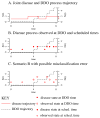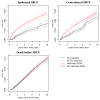A joint model for multistate disease processes and random informative observation times, with applications to electronic medical records data
- PMID: 25319319
- PMCID: PMC4415156
- DOI: 10.1111/biom.12252
A joint model for multistate disease processes and random informative observation times, with applications to electronic medical records data
Abstract
Multistate models are used to characterize individuals' natural histories through diseases with discrete states. Observational data resources based on electronic medical records pose new opportunities for studying such diseases. However, these data consist of observations of the process at discrete sampling times, which may either be pre-scheduled and non-informative, or symptom-driven and informative about an individual's underlying disease status. We have developed a novel joint observation and disease transition model for this setting. The disease process is modeled according to a latent continuous-time Markov chain; and the observation process, according to a Markov-modulated Poisson process with observation rates that depend on the individual's underlying disease status. The disease process is observed at a combination of informative and non-informative sampling times, with possible misclassification error. We demonstrate that the model is computationally tractable and devise an expectation-maximization algorithm for parameter estimation. Using simulated data, we show how estimates from our joint observation and disease transition model lead to less biased and more precise estimates of the disease rate parameters. We apply the model to a study of secondary breast cancer events, utilizing mammography and biopsy records from a sample of women with a history of primary breast cancer.
Keywords: Disease process; Electronic medical records; Informative observations; Markov-modulated Poisson process; Multistate model; Panel data.
© 2014, The International Biometric Society.
Figures




Similar articles
-
Inflation of type I error rates due to differential misclassification in EHR-derived outcomes: Empirical illustration using breast cancer recurrence.Pharmacoepidemiol Drug Saf. 2019 Feb;28(2):264-268. doi: 10.1002/pds.4680. Epub 2018 Oct 30. Pharmacoepidemiol Drug Saf. 2019. PMID: 30375122 Free PMC article.
-
A stochastic estimation procedure for intermittently-observed semi-Markov multistate models with back transitions.Stat Methods Med Res. 2019 Mar;28(3):770-787. doi: 10.1177/0962280217736342. Epub 2017 Nov 8. Stat Methods Med Res. 2019. PMID: 29117850
-
Fitting and interpreting continuous-time latent Markov models for panel data.Stat Med. 2013 Nov 20;32(26):4581-95. doi: 10.1002/sim.5861. Epub 2013 Jun 5. Stat Med. 2013. PMID: 23740756 Free PMC article.
-
Markov-modulated marked Poisson processes for modeling disease dynamics based on medical claims data.Stat Med. 2023 Sep 20;42(21):3804-3815. doi: 10.1002/sim.9832. Epub 2023 Jun 12. Stat Med. 2023. PMID: 37308135
-
Multistate models for the natural history of cancer progression.Br J Cancer. 2022 Oct;127(7):1279-1288. doi: 10.1038/s41416-022-01904-5. Epub 2022 Jul 11. Br J Cancer. 2022. PMID: 35821296 Free PMC article.
Cited by
-
Doctor AI: Predicting Clinical Events via Recurrent Neural Networks.JMLR Workshop Conf Proc. 2016 Aug;56:301-318. Epub 2016 Dec 10. JMLR Workshop Conf Proc. 2016. PMID: 28286600 Free PMC article.
-
Methodological challenges in studying disease processes using observational cohort data.Jpn J Stat Data Sci. 2025;8(1):323-345. doi: 10.1007/s42081-024-00276-9. Epub 2024 Oct 30. Jpn J Stat Data Sci. 2025. PMID: 40547002 Free PMC article.
-
Breast density and risk of breast cancer: masking and detection bias.Am J Epidemiol. 2025 Feb 5;194(2):441-448. doi: 10.1093/aje/kwae245. Am J Epidemiol. 2025. PMID: 39098823 Free PMC article.
-
Bayesian inference for continuous-time hidden Markov models with an unknown number of states.Stat Comput. 2021;31(5):57. doi: 10.1007/s11222-021-10032-8. Epub 2021 Aug 10. Stat Comput. 2021. PMID: 34776654 Free PMC article.
-
Variable Selection for Progressive Multistate Processes Under Intermittent Observation.Stat Med. 2025 Mar 15;44(6):e70023. doi: 10.1002/sim.70023. Stat Med. 2025. PMID: 40110762 Free PMC article.
References
-
- Aalen OO. Phase type distributions in survival analysis. Scandinavian Journal of Statistics. 1995;22:447–463.
-
- Andersen PK, Keiding N. Multi-state models for event history analysis. Statistical Methods in Medical Research. 2002;11:91–115. - PubMed
-
- Andreetta C, Smith I. Adjuvant endocrine therapy for early breast cancer. Cancer letters. 2007;251:17–27. - PubMed
-
- Baum L, Petrie T, Soules G, Weiss N. A maximization technique occurring in the statistical analysis of probabilistic functions of Markov chains. Annals of Mathematical Statistics. 1970;41:164–171.
-
- Boer R, Plevritis S, Clarke L. Diversity of model approaches for breast cancer screening: a review of model assumptions by the Cancer Intervention and Surveillance Network (CISNET) Breast Cancer Groups. Statistical Methods in Medical Research. 2004;13:525–538. - PubMed
Publication types
MeSH terms
Grants and funding
LinkOut - more resources
Full Text Sources
Other Literature Sources
Medical

